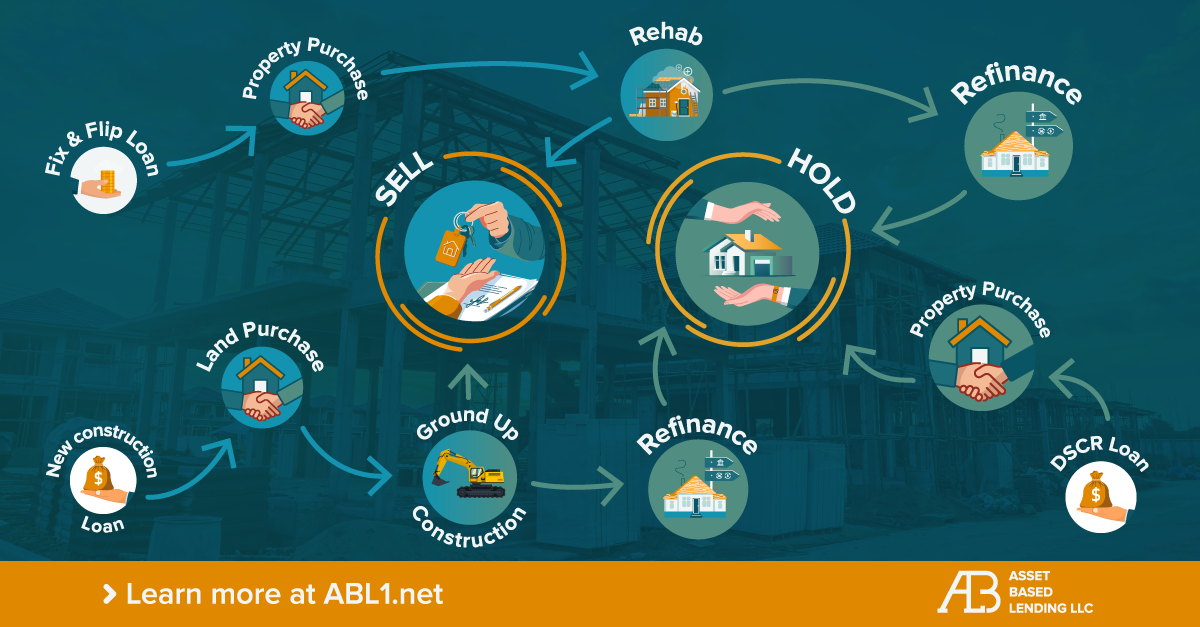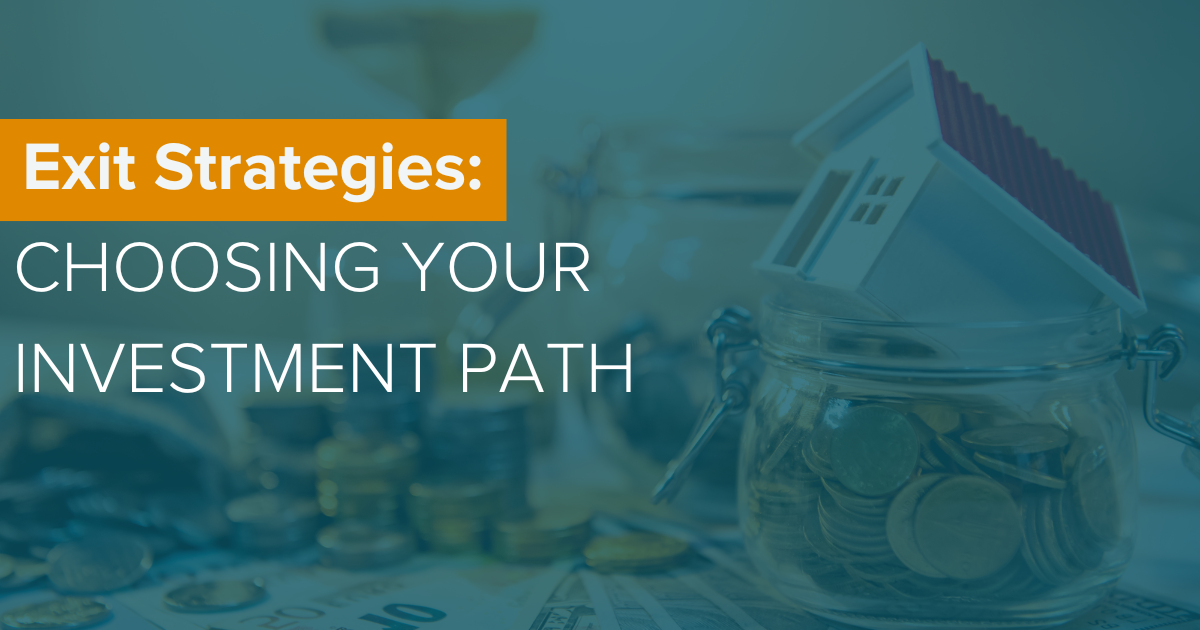When setting your goals for real estate investing it is common for industry professionals to ask what your exit strategy looks like. This is not only a question about your financial goals but also a way to find out the type of investment you are making.
Typically, real estate investors fall into two categories: short term and long term. The difference between the two categories is whether you intend to sell for a profit or hold the property as an income-producing asset. This is often referred to as your exit strategy. There are many combinations of ways investors can take the next steps on their real estate investing journey and have access to loan structures that support each option. In all cases it is necessary for the borrower to know what their investment goals are before getting started.
Do you want to build a portfolio quickly with faster property turnover? Or do you want to grow your business slowly and capitalize on consistent cashflow and appreciation of your investment?
One thing to keep in mind when building your exit strategy is your return on investment, or ROI. When considering a short term investment like fixing and flipping homes or building new construction, the main goal is to recoup the total amount of money invested and make a profit. Whereas, with a long term investment, the goal is to cover all of your monthly operating expenses with the monthly rent, and benefit from the cashflow and property appreciating over time.

Short Term Investment Strategy
Many investors choose to make short term real estate investments through projects that are either fix and flips or new constructions. These types of projects ideally take less than 12 months and result in the property being sold before their financing matures. To make this strategy work for you it requires the initial investment (i.e., the purchase of the property, all-in construction costs, and all holding costs like taxes and interest paid on the loan) to be significantly lower than the price you sell the property for once it is complete.
Using this plan can be a successful strategy and generate a lot of profit. But, just like any kind of high return investment, there are some risks involved. It is important to be aware of both the benefits and hazards involved in the short term real estate investment plans.
Upsides
When working on flipping houses or building new construction projects it is necessary to invest as little money up front as possible to maximize your return on your investment. That requires finding a property that is priced well below the market rate, minimizing the construction costs as much as possible, and moving quickly to limit any holding costs. If done properly, investors stand to make as much as a six-figure return with this type of investment strategy.
There are many factors in this kind of deal that need to be considered upfront like if the geographical location is desirable, if the renovation or construction schedule is feasible and can it be executed with minimal delays, and will you be able to sell the property for the expected after repair value once the project is complete. If everything goes to plan investors can realize their return on investment in under 12 months and come out with a nice profit.
With the assistance of a fix and flip or new construction loan from Asset Based Lending this type of strategy becomes even more appealing because these loans only require borrowers to pay monthly interest on their loan until the final payoff. Receiving 100% of the construction financing and limiting the holding costs to interest only means you can mitigate the possibility of a high monthly mortgage payment like you would have with a traditional lender and in turn maximize your profits.
One of the main criteria that lenders use when considering a borrower is the number of successful projects they have completed in the last three years. When you choose the short term investment strategy you benefit from being able to build your portfolio much faster than someone using the long term investment strategy. For instance, if you follow a fix and flip model you have the potential to be in and out of a project in less than eight months. At that point you can reinvest your money in a new property that same year and grow your portfolio to two properties in a year’s time.
Another factor that comes up with any real estate investment strategy is your holding costs. Holding costs refer to any costs incurred over the duration of owning a property including monthly payments made on your loan, taxes, and insurance, as well as any costs for labor and materials toward the construction. With a short term real estate investment the idea is these costs will only last for a short time. With an ABL bridge loan some of those expenses are alleviated because, instead of making monthly mortgage payments, we only require payment on the interest until the loan is matured. For experienced real estate flippers this is a desirable loan structure, especially when they are capable of completing a fix and flip in under the 12 month term.
By following this investment model investors benefit from a faster turnover of their funds. This means that their investment can turn a profit quickly and the investor can reinvest their money in the next property purchase, making their real estate investment portfolio grow at a much faster rate. When investors successfully complete fix and flips or new construction projects and grow their real estate investment portfolio quickly, lenders like ABL have more confidence in their lending. The Loan Officers at ABL take these successes into consideration when borrowers come back for financing on new projects.
Downsides
The terms of ABL’s fix and flip and new construction loans specify 12 months, which means borrowers have a year from the start of the loan until the loan is matured, at which time the funds need to be paid back in full. For these types of projects most investors intend for their properties to be listed on the market for sale prior to the maturity date of their loan. Experienced investors can complete these kinds of projects in less than 12 months, sometimes even less than six months, and minimize their holding costs while maximizing their profits. No matter your level of experience, every investment opportunity holds risks. It is always possible for delays to occur, things like permit delays, unreliable contractors, or volatile real estate markets, can throw schedules off and even take longer than the loan terms allow. This is a tricky position for investors to be in because it means they are on the hook with their lender for funds they do not have until they sell their property.
Working with reliable partners throughout the entire process, from contractors to vendors, can make or break a project. It is important for investors to vet their partners before taking the first steps into real estate investing. Unforeseen issues have the potential to sabotage a good deal because they can quickly run up the tab on your investment and destroy any potential for profits. When investors find themselves in sticky situations like this, Asset Based Lending has some helpful bridge financing options to bring our investors through these hardships. Refinancing from a fix and flip or new construction loan into a 2-Year Stabilized Bridge Loan can be a useful tool when borrowers have completed their construction but are unable to sell a property due to market conditions. This financing option includes 24 month interest only terms which gives borrowers the luxury of time. With this loan you can own the property for up to two years and list it for sale when market conditions are more favorable, or even put renters in place and generate some cash flow.
While short term real estate investments can bring high yield returns, this strategy comes with inconsistent income. Between the time of purchase and all the way through sale of the finished property investors stand to make no money, and in fact incur carrying costs on things like insurance and taxes as well as your interest payments on your hard money financing. For this reason, short term real estate investing is not possible for a lot of people. Most investors do not start their journey as full time fix and flippers or property developers. In many cases, investors will take on real estate investing as a side project and create supplemental income. Eventually, once you are a seasoned investor, the idea that you won’t see regular income from your short term investments becomes less stressful because you are making enough profit off of your deals to cover your expenses between sales.
Becoming a full time real estate investor has the potential to help you realize financial freedom. To accomplish financial freedom, a successful investor will consider every possible scenario and outcome for their investments, that way if things go awry, they have a plan in place. When you open a short term loan with Asset Based Lending, like a fix and flip or new construction loan, you have a partner that will help you through challenging times. We understand that the real estate market is ever changing and has been volatile in recent years, and we have developed loan products that help our borrowers bridge the gap. With products like the 2-Year Stabilized Bridge Loan to fall back on you can feel more confident in your future as an investor.
Long Term Investment Strategy
In contrast to short term real estate investment strategies the long term investment strategy centers around the concept of holding onto properties as part of their rental portfolio. Many of these projects often begin their cycle with bridge loans to complete renovations and updates and make the properties more appealing for renters. But, when the renovations are complete, instead of selling the property, investors will refinance into a long term rental loan. Holding properties in your portfolio allows investors to reap the benefits that come along with this strategy.
Upsides
The buy and hold strategy means that, as the investor, you have access to stable cash flow from rent. Once a property is renovated, placing renters in the space generates monthly income which you collect as the property owner. The monthly income should be at a rate that is in line with the current rental market rates for that area and be enough to cover the monthly expenses for the property. As the property owner, it is important to understand the geographical real estate market you are participating in to be able to charge fair market rent. If you purchase a property that has high costs to own, like a high monthly payment to your lender or high property taxes, you may have to charge an above average rent and may end up having a hard time finding consistent renters to occupy the space. Knowing the comparable properties in your area will help you identify the feasible rent range and help to ensure you always have a renter in place. Having a renovated property that is priced right for the area is a sure-fire way to maintain consistent cash flow front renters, making your long term investment a success.
When a rental property is successful, and your property is creating a steady flow of income, it is common for investors to use the profits from their property to purchase more rental properties. Growing your rental portfolio is a very effective long term real estate investment strategy. Having multiple rental properties means you are generating multiple streams of income and capitalizing on the other benefits of long term real estate investments. This is often referred to as the BRRRR Method which stands for Buy, Rent, Rehab, Refinance, Repeat. This is a very common path that many investors take because it is easily replicated and helps investors to scale their business quickly.
In general, property is an asset that appreciates over time, in contrast to an asset like a car that depreciates once you drive it off the lot. Property owners benefit from the consistent appreciation of their investment especially when they hold onto it for a long period of time. Though this is a slower method to generate wealth it is an effective way to build wealth with a little bit of patience. In many real estate markets across the country the rate of appreciation on property is worth the time required to benefit from this strategy. When your investment property appreciates it adds to the property’s value and makes your loan to value ratio more favorable for you.
Part of investing in property is understanding the finances behind the investment and how making regular payments towards your loan builds equity in your property. Property equity refers to the difference between the value of your property versus the amount you owe your lender. When you consistently pay down a loan like ABL’s DSCR rental loan you build up equity and increase your wealth. Equity and appreciation work hand in hand to create healthy real estate investment portfolios and in turn makes you a more favorable candidate to lenders. In real estate, many investors will treat their equity like a line of credit to do things like pay for unforeseen expenses or even purchase another property to add to their portfolio. Owning real estate long term and staying current with your lenders will only positively impact your success as an investor as well as your return on investment. When you pay down the principal on a long term loan, like our 30-year DSCR loan, over time your monthly expenses will become lower than the rent you are collecting and therefore turn more profit.
Downsides
A factor that can hinder the potential your property holds for appreciation is the upkeep. If your property is under-maintained and falls into disrepair the value can sharply decrease and it will become more difficult to find or keep renters in place. That’s why it is necessary to stay on top of any repairs or renovations that the property needs. For investors that prefer to keep all their operations in-house, this can become a cumbersome task. You must assume the role of the landlord and property manager, and that sometimes entails taking middle-of-the-night calls from renters when there is an emergency. To alleviate that pressure, many long term investors will hire a third-party property manager to take care of these kinds of problems. Of course, this means you have another expense that needs to be covered with the rent, but the convenience can make this option worth it.
One of the most challenging aspects of long term real estate investing is making sure you don’t have any vacancies. When you experience vacancies in your rental properties that means you are not collecting income to cover your property expenses, but the expenses still need to get paid. Choosing the right location and pricing your rentals competitively are two of the main factors in keeping your rentals occupied. When you are looking for financing for your long term investments, lenders like ABL will take you area’s appraised market rents into consideration. It is necessary for investors to use all the resources available to them to research the rental market before committing to a property. Researching comparable properties, calculating the total monthly expenses, and analyzing the rental market are key steps to determining if you are making the right move for your long term real estate investment strategy.
Conclusion
Whether you are looking to build your real estate investment portfolio quickly by flipping homes, or playing the long game with rental properties, there are benefits and challenges that come along. Asset Based Lending works with our borrowers to help make the best, most profitable, decisions and guides borrowers through tough situations. As hard money lenders we understand the complexities that each investment strategy comes with and have worked to build useful financing options to make our borrowers successful. To learn more about our short term and long term hard money financing options, please visit our Loan Programs page or reach out to one of our Loan Officers.







0 Comments